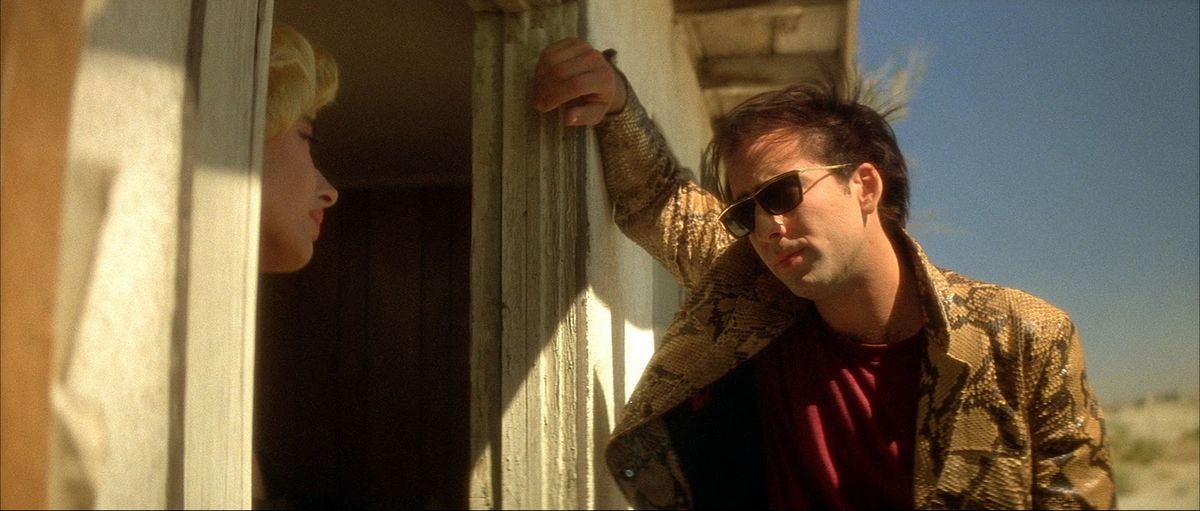Film Society x The Student: “Wild At Heart”
Contributing Writer Caden Stockwell ’25 reviews David Lynch’s 1990 film “Wild At Heart,” comparing it to “The Wizard of Oz” and contrasting it with Lynch’s other work.

“There’s not a day that goes by that I don’t think about the Wizard of Oz,” said writer, director, actor, photographer, singer-songwriter, painter, carpenter, and leading practitioner of transcendental meditation David Lynch at the 2001 New York Film Festival following a screening of his film “Mulholland Drive.” Traces of Victor Fleming’s 1939 classic are evident throughout the artist's work, from his recurring themes of doppelgangers and alternate worlds, to the presence of “Garland Avenue” in the film “Lost Highway” and the mysterious “Judy” in “Twin Peaks: The Return.” Never can the influence of “The Wizard of Oz” be seen more plainly than in his 1990 romantic crime drama “Wild at Heart,” which acts as a retelling of the classic tale.
The film, which stars Nicolas Cage and Laura Dern as Sailor Ripley and Lula Fortune, respectively, a fiery young couple, starts with a bang. It opens at a lavish ball “somewhere near the border between North and South Carolina.” Sailor is almost instantly attacked by a knife-wielding man, causing him to violently murder the man with his bare hands. Lula’s domineering mother, Marietta (Diane Ladd), is revealed as the culprit behind the attempted killing, and Sailor and Lula are forced to go on the run, leaving their home behind and quickly jumping into the plot. The smash of an opening speaks to the manic pace of the film. As much as it is clearly a Lynch film, it also contains the hallmarks of any Nic Cage adventure, with its raunchy camp and absurdity.
Sailor is a wild and romantic young man who dresses like Elvis and wears a snakeskin jacket, which he repeatedly declares to be “a symbol of my individuality and my belief in personal freedom.” Lula is an equally free and uncontrollable woman, who wears ruby red slippers (just like Dorothy) and loves Sailor with all her heart. On the road, the two dance and party to heavy metal, get into fights, and have sex. Sailor has a tendency to burst into song, and Lula begs him to sing her “Love Me Tender,” the classic Elvis ballad, which Sailor says he will only sing to his future wife. Their lifestyle of mayhem and debauchery can only last so long, though, as Lula’s mother strongly disapproves of Sailor and has hired a cast of men to kill him.
Harry Dean Stanton and J.E. Freeman play an affable private detective and a sadistic gangster respectively, both hired by Marrieta. However, the biggest threat to the couple comes randomly, around three-quarters into the film, in the form of Bobby Peru (Willem Dafoe), a psychotic career criminal who ends up in Sailor and Lula’s path by pure chance but quickly wreaks mayhem in their lives. Dafoe is a major highlight of the film, entering suddenly and swerving its trajectory, offering one of his best and most disturbing performances.
The film is episodic, not following a traditional three act structure but instead a large number of mostly independent scenes detailing different chapters in Sailor and Lula’s journey as they evade their many pursuers on their path down “the yellow brick road.” This structure is perhaps in part a result of the fact that “Wild at Heart” was the only feature film Lynch directed at the same time as his ’90s classic television show “Twin Peaks.” The film features a number of cameos from “Twin Peaks” cast members.
In one heartbreaking scene, Sailor and Lula encounter a young woman played by Sherilyn Fenn (known for her role as Audrey Horne in “Twin Peaks”), who has just been in a violent car crash and dies before their eyes. Another scene features Jack Nance (Pete Martell in “Twin Peaks”), an associate of Bobby Peru who rambles somewhat incomprehensibly about a dog he once had. These cameos have nothing to do with the plot overall but serve as signs for what’s to come. The film is unconcerned with traditional narrative: Like “The Wizard of Oz,” it’s about the stops along the journey and the people they meet.
The most important cameo, however, comes at the very end of the film. Sailor has just been released from prison after serving time for six years after a bad encounter with Peru. He visits Lula and their son, whom he is meeting for the first time, but quickly leaves, saying that they will be better off without him. He encounters a group of gangsters and picks a fight, which he badly loses. Wounded and delirious, he receives a visit from Glinda the Good Witch, played by Sheryl Lee (the iconic face of “Twin Peaks”’ Laura Palmer), who tells him not to turn away from love, and that “if you’re truly wild at heart, you’ll follow your dreams.” He gets up, apologizes to the gangsters, finds Lula, sings her “Love Me Tender,” and the film ends.
Just like “The Wizard of Oz” and Dorothy’s profound realization that “there’s no place like home,” “Wild at Heart” is about the beauty of what’s right in front of you. Just as Dorothy must venture to Oz to find the wonder of her own life, Sailor and Lula must venture through hell, traversing a web of crime, violence, and fantasy in order to realize just how strong their love for each other is and the comfort they can find right in front of them.
“Wild at Heart” is often overlooked in Lynch’s filmography. But the film’s outstanding ensemble, frantic direction, and all-timer ending make it just as good as his best works. For a film so full of violence, it left me with a massive smile on my face, and a belief that maybe, just maybe, the love we all need is right before our eyes already.





Comments ()